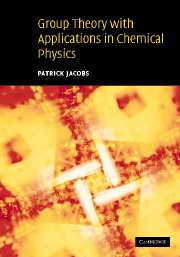Book contents
- Frontmatter
- Contents
- Preface
- Notation and conventions
- 1 The elementary properties of groups
- 2 Symmetry operators and point groups
- 3 Matrix representatives
- 4 Group representations
- 5 Bases of representations
- 6 Molecular orbitals
- 7 Crystal-field theory
- 8 Double groups
- 9 Molecular vibrations
- 10 Transitions between electronic states
- 11 Continuous groups
- 12 Projective representations
- 13 Time-reversal symmetry
- 14 Magnetic point groups
- 15 Physical properties of crystals
- 16 Space groups
- 17 Electronic energy states in crystals
- 18 Vibration of atoms in crystals
- Appendices
- References
- Index
Preface
Published online by Cambridge University Press: 10 December 2009
- Frontmatter
- Contents
- Preface
- Notation and conventions
- 1 The elementary properties of groups
- 2 Symmetry operators and point groups
- 3 Matrix representatives
- 4 Group representations
- 5 Bases of representations
- 6 Molecular orbitals
- 7 Crystal-field theory
- 8 Double groups
- 9 Molecular vibrations
- 10 Transitions between electronic states
- 11 Continuous groups
- 12 Projective representations
- 13 Time-reversal symmetry
- 14 Magnetic point groups
- 15 Physical properties of crystals
- 16 Space groups
- 17 Electronic energy states in crystals
- 18 Vibration of atoms in crystals
- Appendices
- References
- Index
Summary
Symmetry pervades many forms of art and science, and group theory provides a systematic way of thinking about symmetry. The mathematical concept of a group was invented in 1823 by Évariste Galois. Its applications in physical science developed rapidly during the twentieth century, and today it is considered as an indispensable aid in many branches of physics and chemistry. This book provides a thorough introduction to the subject and could form the basis of two successive one-semester courses at the advanced undergraduate and graduate levels. Some features not usually found in an introductory text are detailed discussions of induced representations, the Dirac characters, the rotation group, projective representations, space groups, magnetic crystals, and spinor bases. New concepts or applications are illustrated by worked examples and there are a number of exercises. Answers to exercises are given at the end of each section. Problems appear at the end of each chapter, but solutions to problems are not included, as that would preclude their use as problem assignments. No previous knowledge of group theory is necessary, but it is assumed that readers will have an elementary knowledge of calculus and linear algebra and will have had a first course in quantum mechanics. An advanced knowledge of chemistry is not assumed; diagrams are given of all molecules that might be unfamiliar to a physicist.
The book falls naturally into two parts. Chapters 1–10 (with the exception of a few marked sections) are elementary and could form the basis of a one-semester advanced undergraduate course.
- Type
- Chapter
- Information
- Group Theory with Applications in Chemical Physics , pp. xi - xiiPublisher: Cambridge University PressPrint publication year: 2005

